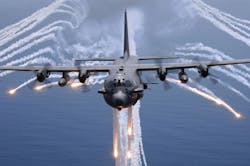Leidos to develop technologies to defend U.S. combat aircraft from multispectral missiles and laser weapons
WRIGHT-PATTERSON AFB, Ohio – U.S. Air Force researchers needed a company to develop prototype threat-warning avionics to help defend U.S. combat aircraft pilots from radar- and electro-optically guided missiles, laser weapons, and other anti-aircraft technologies. They found their solution from Leidos Inc. in Reston, Va.
Officials of the Air Force Research Laboratory at Wright-Patterson Air Force Base, Ohio, announced a $40.8 million contract to Leidos last month for the Electro-Optic Sensing Defensive Electronic Warfare (EOS-DEW) program.
Leidos experts will investigate enabling technologies to help defend aircraft from multispectral guided missiles, hostile fire, and directed-energy weapon systems such as high-power lasers and electromagnetic weapons like high-power microwaves.
U.S. combat aircraft must penetrate and operate in enemy airspace, where they face a variety of sensor-guided missiles, machine guns, lasers, and electromagnetic weapons. The problem with this is existing countermeasures are becoming obsolete as enemy weapons technologies overtake them.
Related: Laser weapons get ready for the big time
Air Force researchers are asking Leidos to find solutions to counter each new identified threat. For example, effective missile countermeasures rely on early launch detection and continual improvements in missile warning sensors. Directed energy threat detection, on the other hand, requires several different laser detection schemes.
Validating new sensor architectures requires specialized and customized testing that involves high fidelity threat simulation, radiometry, platform motion simulation, tracker characterizations, and data analysis techniques.
Leidos will focus on multi-spectrum threat warning for enemy missiles, laser weapons, and hostile fire. primarily focusing on o Missile sensing o Laser sensing o Hostile fire sensing; multi-spectrum threat simulation; sensing technology evaluation; fielded systems; and developmental components to advance the state of the art in multispectral threat sensing systems.
The company will perform component hardware and algorithm development and evaluation; investigate emerging technologies in threat detection techniques and discriminants; system development; threat signature simulation; and will evaluate environment development and integration.
Simulation development will involve replicating threat signatures in hardware-in-the-loop laboratory and field settings. Leidos will focus on threat signature simulations of missiles, lasers, hostile fire, kinematic motion, real-time radiometrics, atmospheric turbulence, and scene clutter.
Modeling and simulation work will involve aircraft and missile plume signatures; atmospheric effects; transmission; scattering; turbulence; missile-engagement 3D modeling; and laser propagation.
The company will perform work at the Naval Air Warfare Center (NAWC) test range, Calif.; Yuma Proving Ground, Ariz; White Sands Missile Test Range, N.M.; Eglin Test Range, Fla., using government-provided threat warning systems, instrumented threat sensors and seekers, search-and-track sensors, other countermeasures equipment, data collection devices, support equipment, and portable laser equipment.
For more information contact Leidos online at www.leidos.com, or the Air Force Research Laboratory at www.afrl.af.mil.
About the Author
John Keller
Editor-in-Chief
John Keller is the Editor-in-Chief, Military & Aerospace Electronics Magazine--provides extensive coverage and analysis of enabling electronics and optoelectronic technologies in military, space and commercial aviation applications. John has been a member of the Military & Aerospace Electronics staff since 1989 and chief editor since 1995.
